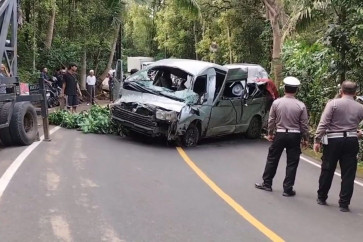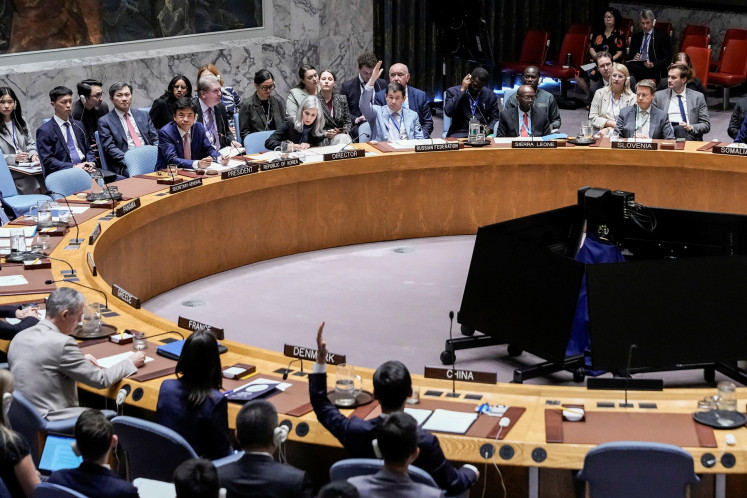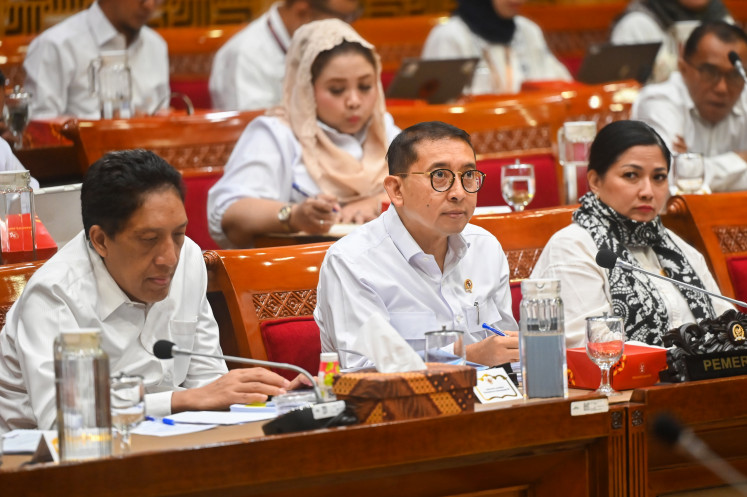Popular Reads
Top Results
Can't find what you're looking for?
View all search resultsPopular Reads
Top Results
Can't find what you're looking for?
View all search resultsJakarta's traffic gridlock: The malady of `macet'
The term macet, meaning traffic gridlock or deadlock, is synonymous with Jakarta
Change text size
Gift Premium Articles
to Anyone
The term macet, meaning traffic gridlock or deadlock, is synonymous with Jakarta.
This, however, should come as no surprise given that domestic automotive sales have grown at an average annual rate of 11 percent per year since 2002, according to the data published by the Indonesian Automotive Body (GAIKINDO).
In 2008 alone, sales of 4-wheel vehicles (4W) reached 607,000, up 40 percent from 2007.
With 50 percent of sales in the greater Jakarta area, the total number of vehicles registered in the local authority has reached more than 3 million.
Even worse is the number of motorcycle riders in Jakarta, which reportedly reached 3.5 million in 2007.
According to Jakarta's regional police authority, motorcycle registration per year ranged from 250,000 to 350,000 over the past six years.
Putting all the figures together; assuming 40 percent of the total sales (6.2 million vehicles) was channeled into Jakarta, the number of motorcycle users in the capital would have reached 6 million in 2008.
Thus, the total number of vehicles (i.e. cars plus motorcycles) registered in Jakarta will now be approximately 9 million.
Looking toward the future, this number is likely to skyrocket further given the Indonesian domestic automotive market has predicted that by 2015, the number of car sales will reach 1 million vehicles per year.
This means that vehicle sales are expected to grow at a compounded annual growth rate (CAGR) of close to 9 percent per year in the next six years.
This will undoubtedly only complicate and eventuate Jakarta's notorious gridlocks. The issue of traffic congestion has become a major government focus. While several transformation plans have been designed and implemented, no significant improvements have materialized thus far.
An alternative measurement of traffic flows can also be derived from analyzing the volume of vehicles passing on the Cawang-Tomang-Cengkareng toll road, which today remains at high density of 180 million vehicles per year or around 500,000 vehicles per day. This figure that has remained unchanged since 2004, suggests full capacity.
In fact, the growth of roads in Jakarta is less than 1 percent per annum. Thus, the comparison of the average growth of vehicle sales per year, at 11 percent per year since 2002, to the frequency of development projects and upgrades for the city's roads suggest a serious deficit in the capacity of the city's roads.
In addition to this, expansions of road lanes to solve congestion has not offered a panacea, as there is extremely limited space on which to extend.
In short, many roads have already reached maximum capacity.
To complicate matters, there is a possibility that motorcycles will be allowed to go through toll roads, which in our view, would just exacerbate matters.
The only real solution for combatting traffic congestion is the development of a new transportation system. Concrete evidence of this would have been the realization of the Transjakarta Busway as a new form of rapid transport in 2004.
Until the end of 2008, the busway had managed to accommodate an average of 240,000 passengers per day. But unfortunately, the existence of the Busway has not triggered any significant shifts, as individuals continue to use their cars and motorcycles more than ever.
Thus, major overhauls through the establishment of a new transportation network, with a high level of suitability, is a necessity for unlocking Jakarta's gridlock problem.
Initially, the government managed to start a monorail project, but failed to complete it. The classical problem remains as the feasibility of the projects, deemed to be unprofitable, would certainly require government subsidies.
Nevertheless, we believe the adoption of an integrated transport system in the form of a monorail or a subway system would be highly effective in easing traffic congestion.
An alternate solution that has been discussed over the past few years is to limit car ownership and implement a progressive tax (stepped-up tax) for multiple car owners.
The automotive industry, however, has strongly opposed this plan which it says would reduce car demand and could result in greater unemployment within the sector.
In our view, however, the implementation of such a policy would be pointless without the availability of a solid public transportation system. The government must first provide a viable alternative transport system that will prompt car users to voluntarily use public transportation. This will require commitment from the government to keep the system and related facilities clean and safe for commuters. Until this tall order can be accomplished, the malady of macet is here to stay in Jakarta.
The writer is a research analyst at Bahana Securities










